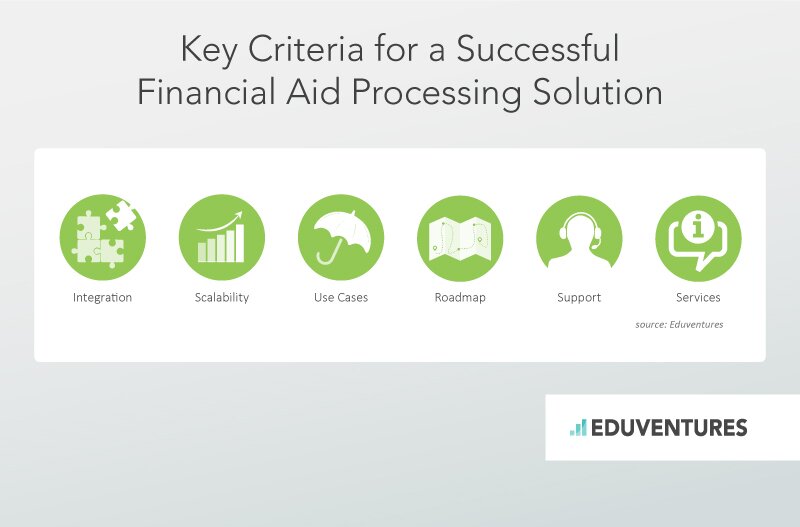At first glance, one might think that financial aid solutions should satisfy three key requirements: allow students to apply for, track, and receive funding. Any solution that meets these needs would seem entirely suitable. In reality, however, financial aid is a complex web of systems. Any solution worth considering must be able to handle the complexity of the contemporary financial aid ecosystem.
There are three main factors that contribute to the emerging complexity in financial aid. First, there is a widening gap between the cost of tuition and availability of financial aid. Second, there are many challenges to overcome in obtaining the right amount of funding from a broad range of sources (federal and state grants, loans, scholarships, etc.). Finally, students find it difficult to get a clear, simple view into their financial aid status. There are an overwhelming number of information sources, including FAFSA, National Student Loan Data System (NSLDS), financial aid history, tax information, etc. Taken together, these factors place students in a pressurized environment where, as some recent surveys have shown, students may leave college well before completion.
We believe that successful financial aid solutions need to help stakeholders navigate complexity and create a streamlined and easy-to-navigate environment for students. Earlier this year, we decided to develop a report, “Financial Aid Processing: A Competitive Analysis,” in which we reviewed the current set of financial aid solutions in the marketplace with an eye towards helping institutions have a clear-eyed approach to selecting and deploying the right solution. In this report, we derived and applied a set of criteria that applies broadly to key use cases based on vendor interviews, product demonstrations, and follow-up conversations. Using these criteria, we evaluated the strengths and weaknesses of the products from 14 vendors: Ellucian, Oracle, Campus Management, Jenzabar, Workday, UNIT4, Tribal, Campus Logic, Vocado, College Board, CORE, Education Partners, and Regent Education.
Later this summer we will conduct a webinar discussing the full set of results. We thought, however, that it might be useful to provide some key findings, as well as highlight a few top-rated products, in advance of our webinar.

One of the aims of this report is to clarify the market for financial aid processing tools and point out areas of differentiation between these tools. View and download this report on NRCCUA’s Data Lab.
Financial Aid Processing: A Competitive Analysis
Key Criteria for a Successful Financial Aid Processing Solution
While it is often difficult to determine the best criteria by which to evaluate software products, our review of the marketplace and stakeholders showed some specific areas that a financial aid solution would need to address to be successful:
- Integration. Product integrates with other solutions, i.e. enterprise resource planning (ERP) and student information system (SIS), to get required enrollment and transactional data
- Scalability. Product scales to meet demand for classes, programs, and institutions of all sizes
- Use Cases. Product fully meets certain critical use cases, including verification of financial data, standard academic progress reporting, document management, ability to handle non-traditional academic years and terms, user experience, ad-hoc and canned reporting, and fund packaging and disbursement
- Roadmap. Clients can drive product roadmap, and the vendor has a track record of anticipating market needs
- Support. Vendor provides multiple training and support options, on-demand, and at reasonable costs
- Services. Vendor provides required services, such as change management and data integration
Our Findings: Top Three Solutions
Although each criterion had more than one stand-out solution, here are our picks on which products stood out the most overall:- Vocado (Vocado). The highest-rated solution in our evaluation, Vocado excelled largely because it scales to the largest numbers of rules, conditions, and exceptions, and because it has the ability to adapt to non-traditional courses and programs. Although we did not give it the highest marks regarding user experience, Vocado has demonstrated their team’s adaptability: they have taken steps since our evaluation to address the user experience in its recently launched Student Portal.
- Regent 8 (Regent Education). The next highest-rated solution was Regent 8, which we liked for its support for multi-campus deployments, multi-year fund packaging and forecasting, as well as its software-as-a-service (SaaS) model. We also liked the plans for deeper integration with its student financial literacy tool, Financial Planner and look forward to providing more updates on the progress of the integration.
- CampusNexus (Campus Management). Rounding out the top three evaluated solutions was Campus Management’s CampusNexus Student product, which impressed us for its close partnership between its services and product teams, allowing for smooth implementation of its solutions. We did find, however, that the scope of the core offering was focused more on administrative use cases and less on others, such as document management and reporting.

